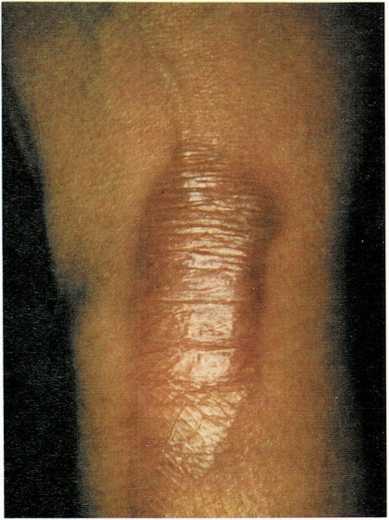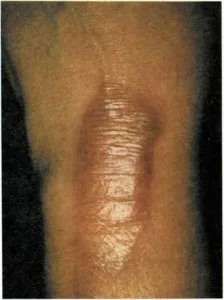Jaundice – Knock-knee
Jaundice is a yellow discoloring of the skin and eyeballs that
results from an excess amount of bile pigment in the bloodstream. It is
a symptom of disease rather than a disease itself. If your child appears
to have jaundice, call the doctor. The doctor will determine the cause
of the jaundice and prescribe proper treatment.
Ordinarily, bile pigment enters the blood as a result of the normal
breakdown of red blood cells. The liver converts the bile pigment from a
complex to a simple chemical form, so that it can pass through the bile
ducts and into the intestinal tract, where it is excreted in the stools.
A number of different conditions may cause jaundice:
- An increased destruction of red blood cells (as may occur in rapidly
developing anemia) ■ An inability of the liver to excrete bile
pigment (as when the liver is damaged)
“`{=html}
“`
An immaturity of the liver that limits its capacity to handle the
pigmentAn obstruction of the bile ducts
An infection of the liver (as in hepatitis) Jaundice in infants may
be completely normal or may indicate a serious disorder. Normal
jaundice occurs in the majority of newborn babies, especially
premature babies. Such jaundice usually begins when the baby is only
2 or 3 days old and disappears by the 5th or 7th day. It may occur
because the immature liver lacks enough enzymes to process the bile
pigment. Usually, no treatment is needed for this condition.
Jaundice that appears within the first 24 hours of the baby’s life
usually is more serious. Incompatibility between the blood types of the
mother and the infant is one of its causes. In such cases, the mother is
usually Rh-negative and the baby Rh-positive. This cause of jaundice is,
however, less common today because of the administration of Rh„ (D)
immune globulin to Rh-negative mothers after a delivery or miscarriage.
Other blood incompatibilities may also be the cause of jaundice in the
newborn. The baby may need one or more exchange transfusions. In an
exchange transfusion, the baby’s blood, which has a high content of bile
pigment, is replaced by blood which has a lower level of bile pigment.
High levels of bile pigment in the baby’s blood have been associated
with brain damage, [m.g.]
See also Anemia; Blood type; Hepatitis; Heredity; Rh factor
Kawasaki disease (mucocutaneous lymph node syndrome) was first
described in Japan in the late 1960’s. The cause of the disease remains
unknown. Although it is most common in Japan, it has been reported
throughout the United States.
Kawasaki disease is an inflammatory disease which begins as a sudden
illness, after which serious complications can occur. The acute illness
usually consists of fever, a rash, red eyes, changes in the lips,
swollen glands, and reddening of the palms and soles. Later, heart
problems, including heart attacks, can occur. Physicians currently treat
children who have Kawasaki disease with gamma globulin and aspirin.
This treatment greatly reduces the chances of cardiac complications. If
parents feel that their child has symptoms of Kawasaki disease, they
should take the child to the doctor to be examined, s.w.
Keloid is a harmless overgrowth of scar tissue that may develop
around cuts, punctures, surgical incisions, or burns. Keloids occur more
often in dark-skinned than in light-skinned people. Doctors do not know
exactly what causes a keloid.
For the first few months, keloids are usually red or pink. Later they
lose this color. They frequently itch and are tender, especially when
clothing rubs against them. You can lessen the itching and discomfort: ■
Dress the child in loose-fitting clothing of nylon or silk. Avoid wool
and cotton.
Try to keep the child from getting overheated.
Gently massage the keloid with lanolin every day.
Your doctor may also recommend the injection of a special cortisone
preparation.

This typical keloid developed around a burn on a boy’s wrist.
This may reduce the size and discomfort of the keloid.
In rare cases, a doctor may remove surgically an uncomfortable or
disfiguring keloid. Unfortunately, keloids may recur even after they are
removed, [t.m.h.]
Knock-knee is a condition in which the legs bend inward and the
knees come close together. Sometimes, a knock-kneed child also looks
pigeon-toed—the toes point together and the heels point outward.
Knock-knee may be positional, or it may be caused by injury or disease
affecting the knee growth centers. If positional, knockknees result from
the position in which a child holds the knees and is more common in
heavier children. The condition appears to look worse until the child is
5 or 6 years old; it then gradually improves. Positional knockknees
usually correct themselves by the time the child is about 9 years old,
and no treatment is necessary. However, if the condition is quite
noticeable in a young child, a doctor may recommend shoe corrections and
a reduction in the child’s weight.
If knock-knee is due to injury to a knee growth center, only one knee is
usually affected. If knock-knees is due to disease involving the knee
growth centers, both knees are usually involved. Knock-knees caused by
injury or disease usually do not coiTect themselves, and medical
treatment is needed. Braces and surgery may be necessary to correct the
knock-knee condition. JJ.G.
See also **Bowlegs; Flat feet; Foot care; Overweight; Rickets

